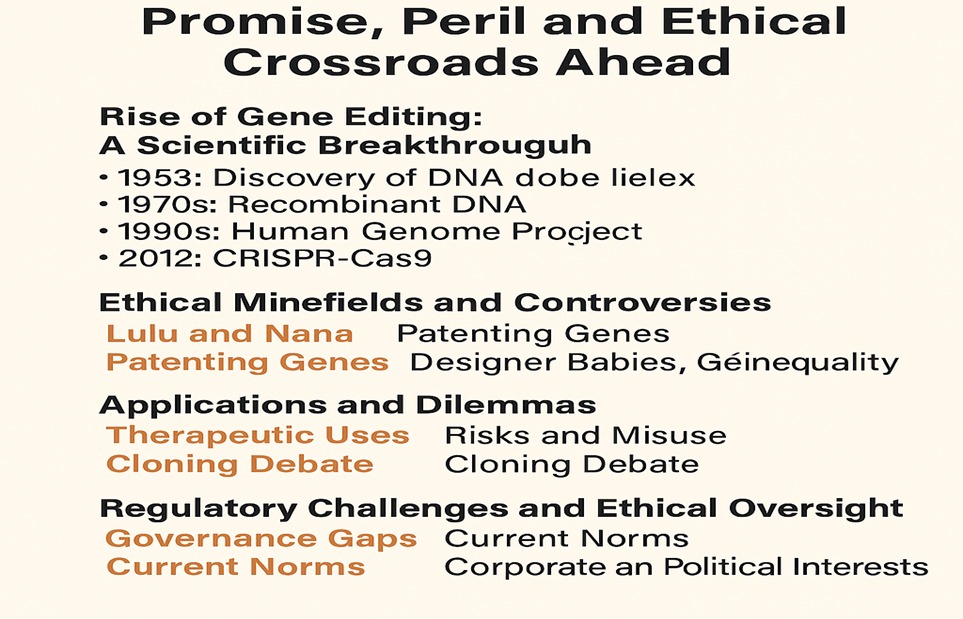Gene Editing: Promise, Peril and Ethical Crossroads Ahead
Gene Editing: Promise, Peril and Ethical Crossroads Ahead
Syllabus:
GS-3:
Biotchnology
Focus:
Recent breakthroughs like CRISPR-Cas9 therapies for sickle cell anaemia in the US and UK mark a major leap in gene-editing technology. While these developments showcase therapeutic promise, they simultaneously reignite ethical concerns, especially regarding designer babies, genetic inequality, and the governance vacuum in regulating gene-editing innovations.
Rise of Gene Editing: A Scientific Breakthrough
• Historical Milestones
- 1953: Discovery of the DNA double helix by Watson and Crick.
- 1970s: Recombinant DNA techniques by Herbert Boyer and Stanley Cohen initiated cross-species gene manipulation.
- 1990s: Launch of the Human Genome Project; by 2003, 92% of the human genome was mapped.
- 2012: Introduction of CRISPR-Cas9—a game-changer due to its simplicity, affordability, and precision.
• Present Capabilities
- CRISPR is already curing genetic diseases like sickle cell anaemia.
- Applications in agriculture, immunotherapy, and climate-resilient crops are underway.
- DIY CRISPR kits raise serious concerns about biohacking and bioterrorism.
What is Gene Editing?● A form of genetic engineering that modifies DNA by inserting, deleting, or replacing sequences at specific genome locations. ● CRISPR-Cas9 is the most precise, cost-effective, and widely used gene-editing tool. Benefits and Applications ● Medical: Treats genetic disorders like sickle cell anemia, β-thalassemia, hemophilia. ● Agriculture: Increases crop yield, pest resistance, and climate tolerance. ● Livestock: Enhances productivity and disease resistance. ● Biomedicine: Enables gene therapies, drug development, and xenotransplantation. ● Disease Control: Engineers mosquitoes to reduce malaria and dengue transmission. ● Industrial: Improves bacterial cultures for food and biofuel production. ● Reproduction: Prevents inherited diseases. ● RNA Editing: Targets and alters single-stranded RNA. Scientific Advancements ● Uses site-directed nucleases (SDNs) for precise genome intervention: ○ SDN1: Small edits without foreign DNA. ○ SDN2: Edits using DNA template, no foreign gene. ○ SDN3: Involves foreign DNA, similar to GMOs. ● CRISPR allows targeted edits, revolutionizing plant breeding and disease models. Strategic Use ● Military: Research into enhancing soldiers’ tolerance to chemical/biological threats. ● Potential for human performance optimization. |
Ethical Minefields and Controversies
• The Lulu and Nana Incident
- He Jiankui edited embryo genes to resist HIV in 2018—first known case of genetically modified humans.
- Triggered global outcry over secret trials and lack of ethical clearance.
• Patenting Genes
- The 2013 US Supreme Court invalidated patents on naturally occurring genes.
- However, synthetic or modified genes remain patentable, raising issues about ownership of human DNA.
• Designer Babies and Genetic Inequality
- Potential rise of a genetic caste system—wealthy individuals enhancing intelligence, height, and disease immunity.
- Socioeconomic divide may be amplified by unequal access to gene enhancement technologies.
Applications and Dilemmas:
• Therapeutic Use Cases
- Reprogrammed immune cells to target tumours with high accuracy.
-
Genetically modified crops like drought-resistant rice and non-browning bananas promise food security.
• Misuse and Risks
- Risks of genetic bioweapons, DIY editing, and bio-dramatics like de-extinction.
- US startup Colossal Biosciences working on resurrecting mammoths, dodos, and dire wolves.
- Concerns of unpredictable ecological consequences.
• Cloning Debate
- Dolly the sheep, the first cloned mammal, raised hopes and moral panic.
-
While animal cloning is used in agriculture, human cloning remains a taboo and ethical red line.
Regulatory Challenges and Ethical Oversight:
• Governance Gaps
- No global regulatory framework exists for overseeing human gene editing.
- Calls for international consensus and strict bioethical guidelines.
• Current Norms
- Therapeutic editing is cautiously accepted.
- Aesthetic or intelligence enhancements are widely debated.
- Editing heritable traits remains banned or heavily restricted.
• Corporate and Political Interests
- The marketisation of genetics risks prioritising profit over ethics.
- Pressure to commercialise genetic innovation may lead to unsafe or premature experimentation.
Looking Ahead: Striking a Moral Balance:
• Bioethics and Public Dialogue
- Ethical frameworks must be evidence-based, transparent, and inclusive of public opinion.
- Educated dialogue is key to preventing science from outpacing ethics.
• The Role of Institutions
- UNESCO, WHO, and national bioethics councils must step up.
- Academia, civil society, and media must raise awareness and hold researchers accountable.
• A Double-Edged Sword
- Like fire or nuclear energy, gene editing is a powerful tool.
- If guided by caution and equity, it can eradicate suffering, ensure food security, and preserve biodiversity.
-
If misused, it could trigger genetic dystopia, deepen social inequalities, and damage ecological balance.
Conclusion:
Gene editing stands at the crossroads of miracle and menace. While its therapeutic promise is undeniable, unchecked enhancement or unethical use could unravel the fabric of society. Humanity must pause to reflect: not just on whether it can edit genes—but whether it should, and under what moral compass.
Source: Mint
Mains Practice Question :
Discuss the ethical, social, and legal challenges posed by gene-editing technologies like CRISPR. How can India strike a balance between harnessing the therapeutic potential of genetic engineering and ensuring equitable, safe, and ethically guided applications in line with global standards?




